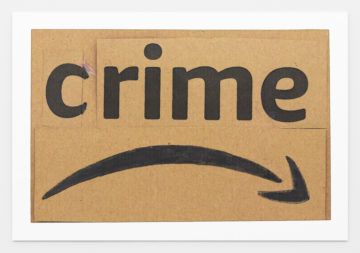Alex Press in Bookforum:
 GET BIG FAST was an early Amazon motto. The slogan sounds like a fratty refrain tossed around at the gym. Jeff Bezos had it printed on T-shirts. More than twenty-five years after leaving his position as a Wall Street hedge-fund executive to found Amazon, Bezos’s size anxiety is long gone. (At least as it pertains to his company; the CEO’s Washington, DC, house has eleven bedrooms and twenty-five bathrooms, a bedroom-to-bathroom ratio that raises both architectural and scatological questions.) Bezos is now worth $180 billion. Amazon, were it a country, would have a larger GDP than Australia.
GET BIG FAST was an early Amazon motto. The slogan sounds like a fratty refrain tossed around at the gym. Jeff Bezos had it printed on T-shirts. More than twenty-five years after leaving his position as a Wall Street hedge-fund executive to found Amazon, Bezos’s size anxiety is long gone. (At least as it pertains to his company; the CEO’s Washington, DC, house has eleven bedrooms and twenty-five bathrooms, a bedroom-to-bathroom ratio that raises both architectural and scatological questions.) Bezos is now worth $180 billion. Amazon, were it a country, would have a larger GDP than Australia.
Such numbers are nonsensically large—there’s no way to make them stick. But in 2017, Bezos demonstrated what they mean. That was the year the company conducted a nationwide sweepstakes to choose a location for its second headquarters, or HQ2, as it was called. Seattle was already a company town: Amazon had more than 40,000 employees there, and as much of the city’s office space as the next forty largest employers combined. It was time to take over a new city.
Local and state governments raced to undercut each other. It wasn’t only tax credits that in some locations amounted to over $1 billion; the subsidies offered to Amazon were a display of abject creativity. Bezos is a Trekkie, so Chicago had Star Trek star William Shatner narrate the city’s pitch video. Tucson, Arizona, sent a giant saguaro cactus to Amazon headquarters. Sly James, Kansas City’s mayor at the time, bought and reviewed one thousand Amazon products, giving every item five stars. But the locations Bezos selected—New York City and Northern Virginia—were always going to win. Together, the chosen bids gave the company over $3 billion in tax incentives and grants.
More here.
